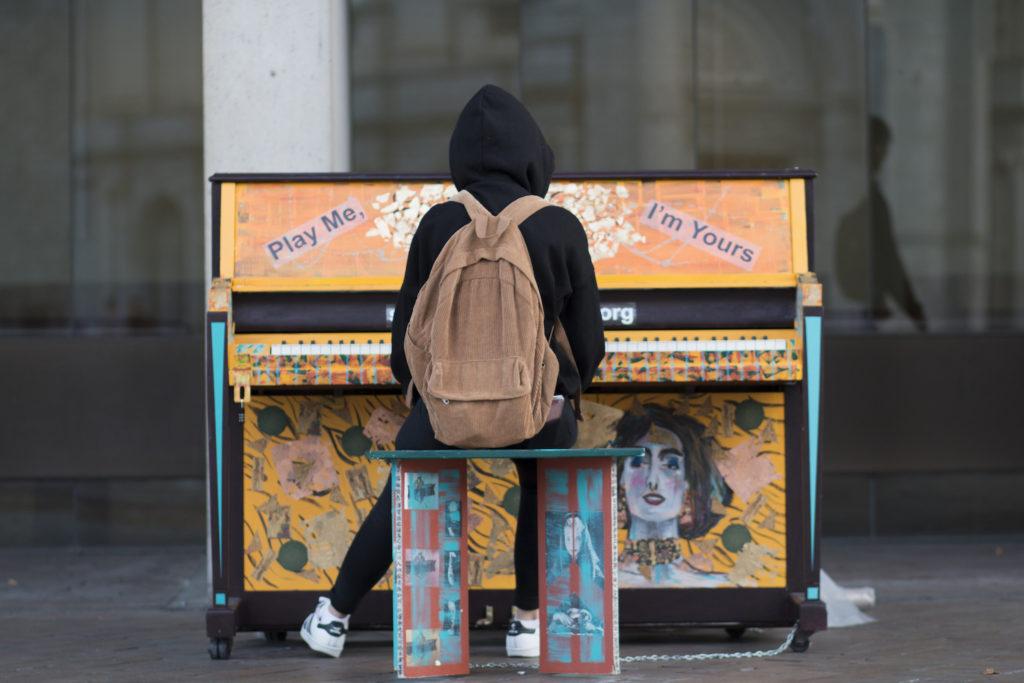By Nainika Vaidya, news correspondent
In the usually-disregarded corners of Boston, residents can now find several beautifully decorated pianos with the words “Play Me, I’m Yours” displayed on large plaques. Street Pianos, an art initiative with 1,500 pianos in 50 cities worldwide, has come to the Boston for the second time since 2013.
“With half a million people participating [last time], we knew we had to bring this back,” said Gary Dunning, president and executive producer of Celebrity Series Boston, the group that organized Street Pianos. “It’s a great project because it just surprises people, engages people.”
This year, Street Pianos held its opening ceremony at City Hall Plaza on Friday, Sept. 23. This year’s initiative consists of 60 pianos around Boston and Cambridge decorated by local artists, Dunning said.
“This is a great project because we’re also working with different community groups, from cultural institutions to storefront neighborhood associations,” Dunning said at the opening ceremony. “The partners are helping to place the pianos, they’re helping to take care of the pianos, they’re looking out after the pianos.”
The project was originally created seven to eight years ago by artist Luke Jerram in Birmingham, England. Since then, the project has bloomed, Jerram said.
“Celebrity Series has done such an amazing job with 60 pianos across the city, literally dotted in every neighborhood around the city,” Jerram said. “The public are going to be amazingly grateful for these pianos that they can play and enjoy.”
Jerram said he wanted the pianos to be decorated so they would seem more approachable and bright to city-goers. The “Play Me, I’m Yours” plaques were inspired by visits to his local laundromat, he said.
“I’d see the same people there every weekend washing their clothes, and no one seemed to talk to another,” Jerram said. “So I thought by putting a piano there it would act as a catalyst for conversation to get everyone engaged and talking with one another.”
The artists who painted the pianos ranged from professionals like Eddie Bruckner to a third-grade class to a Boston University chemistry professor and his Ph.D students, Dunning said.
“We wanted a variety of artists. It wasn’t a juried competition,” he said. “It really was about celebrating diversity of artistry, artists and the neighborhoods.”
Northeastern students Shay Glackin-Coley, a freshman engineering major, and Bailey Coleman, a freshman in the undeclared program, played a bright yellow piano outside the Huntington Avenue entrance to the Museum of Fine Arts.
“I moved into Northeastern recently, and I used to spend hours a day playing piano, and now I don’t have one, and now I do,” said Glackin-Coley.
As the two friends played the piano, strangers passing by and museum-goers sat down on the nearby bench to listen to the melodious sounds. After Glackin-Coley and Coleman played a few harmonies and improvised, the small crowd applauded. The Northeastern students were dismayed to find out that the pianos would only be staying in the city temporarily. They said they had hoped it was part of Boston’s usual scenery.
Others, however, did not have such positive responses to the pianos.
“I don’t like the art. I like it when the pianos stay as they are,” said Ana Ortiz, a junior at the Berklee College of Music majoring in film scoring and conducting. “I’m a classical musician. I’m very straight-minded.”
Ortiz played some pieces on a piano outside the Berklee College of Music Bookstore on Boylston Street with her friend Abigail Shelton, a sophomore at the Berklee College of Music majoring in performance and film scoring. The piano features red and yellow swirls.
“I like it, but I wouldn’t like it in a concert hall,” Shelton said.
Ortiz and Shelton’s piano playing constantly drew people outside of the bookstore until a crowd had gathered. The performance was rewarded with rapturous applause and a continuous stream of praise and compliments. Though they played cheerfully, Ortiz and Shelton both agreed on one thing: The piano was in desperate need of some tuning.
At the graphically-designed dark-blue-and-white piano outside of the Prudential Center on Boylston Street, Benjamin Gelber, an undeclared Northeastern freshman, and Olivia Perez, a freshman biology student at Northeastern, remarked how exciting it was to meet new people at the pianos.
“I’m taking a sociology class that deals specifically with Boston, and my professor mentioned the exhibit to me, just that we go out and play [the pianos] if we can,” Gelber said. “I think it just surprised me how many random people seemingly knew how to play the piano.”
Outside the Boston Public Library in Copley Square, three women from Hong Kong sat around the piano listening to one of their cousins play. Yoyo Wong, a 21-year-old finance major at Boston University, said she would really like to see the pianos stay.
“You can connect people and it also influences others to play this piano,” Wong said. “The atmosphere is good.”
Almost as if to emphasize her point, a man walked up to the three women and asked them if he could play the piano. Joanna Wong, 19, a student at MCPHS University in Boston, stepped aside and let the man play.
Meanwhile, the piano outside the Boston Architectural College on Newbury Street drew people to its location with the strangely intriguing and beautifully intricate faces painted on it. Several groups of friends, couples, families and lone individuals stopped to try their hands on a few chords.
Across Boston and Cambridge, people gathered around the pianos to share something they all have in common: Their appreciation for music.
Street Pianos will be on display throughout Boston until Oct. 10.
Photo by Josh Svoboda















